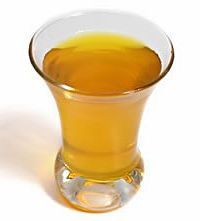 Vinegar is a versatile liquid that results from the fermentation of ethanol in an alcohol-containing liquid, such as wine, fermented fruit juice, or beer. The key ingredient of vinegar is acetic acid, which gives it an acidic taste.
Vinegar is a versatile liquid that results from the fermentation of ethanol in an alcohol-containing liquid, such as wine, fermented fruit juice, or beer. The key ingredient of vinegar is acetic acid, which gives it an acidic taste.
There are two processes of fermentation that differ by speed of production. While the fast fermentation process takes only hours to days, it requires the use of machinery to promote the oxygenation. The slow fermentation process takes weeks to months and occurs naturally.
Vinegar is commonly used in food preparation, particularly in pickling processes, vinaigrette, and other salad dressings. It is an ingredient in sauces such as mustard, ketchup, and mayonnaise. It is often used as a condiment. Marinades often contain vinegar.
There are many different types of vinegars, depending on what liquid the ethanol has been fermented in. In this process, we used Squash peelings to make an inexpensive vinegar. Making Vinegar from squash peelings is a good home-business to start with a low capital investment.
How to make Vinegar from Squash Peelings
Materials:
- 1 kg. kalabasa peels & cores
- 1 1/2 cup sugar
- 1/2 tsp. yeast
- 1 cup vinegar starter
Utensils:
- measuring cup
- measuring spoon
- knife
- chopping board
- casserole
- stovecheese
- clothwide-mouthed glass jars
- thermometer
PROCEDURE:
- Wash peels and cores of kalabasa, add three (3) parts water for every part of peel. Boil for 15 minutes.
- Strain, add 4 c water for every 4 cups of strained liquid from boiled peels/core.
- Add ¾ c sugar for every 4 c diluted liquid.
- Pasteurize at 60 – 65ºC for 10-15 minutes.
- Transfer in a sterilized container half-filled and cool. Add ¼ tsp yeast for every 4 c diluted liquid. Cover with clean cloth/paper.
- Ferment for seven (7) days until alcohol content is about eight (8) percent by volume.
- Pour gently the alcohol solution into another sterilized container so as not to disturb the sediments. Add one (1) cup vinegar starter for every four (4) cups of the solution. Cover with clean cloth/paper.
- Set aside for 15-20 days then determine the acidity which is usually between 6-7 percent.
- Decant/strain. Pasteurize at 60 – 65ºC for 5 minutes.
- Fill in sterilized bottle and seal tightly.
- Label and store.
Source: DOST; Photo: recipetips.com